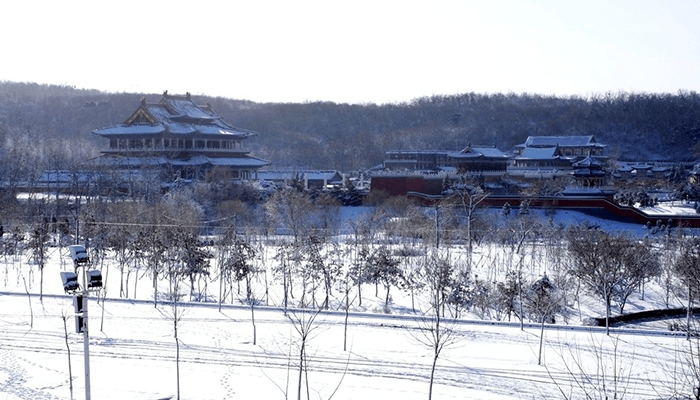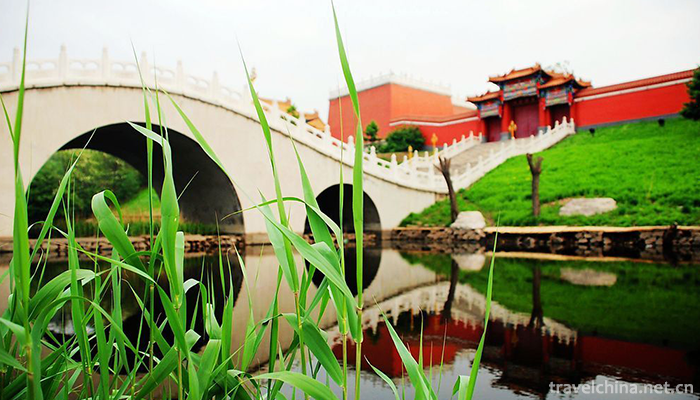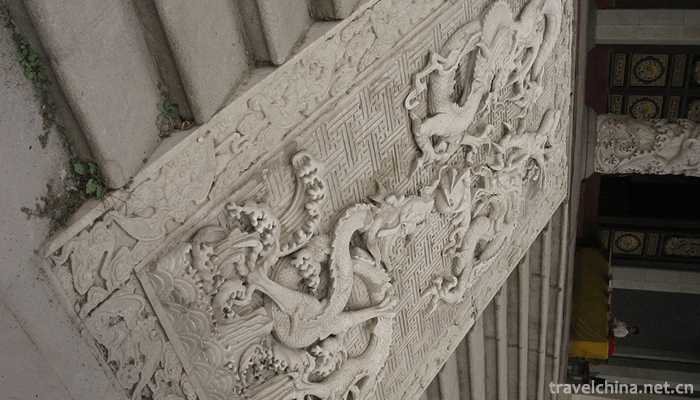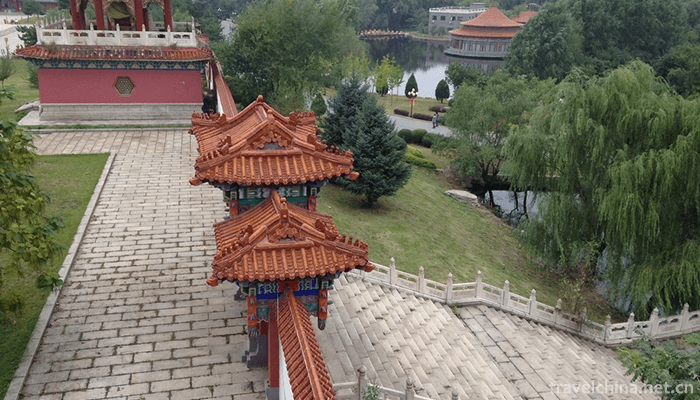Jade Buddha Garden
Yufo Garden is a famous tourist attraction in Anshan. It is located in the core scenic area of Yufo Mountain. It covers an area of 270,000 square meters. It is surrounded by mountains on three sides and faces water on one side. It is famous both at home and abroad for its worship of the world's largest jade Buddha. Jade Buddha Garden is mainly composed of Jade Buddha Pavilion, Tianwang Hall, Saili Hall, Pharmacist Hall, Tibetan Hall and Arhat Holy Land. It integrates Jade Culture, Buddhist Culture and Landscape Garden Culture. The main body of the Jade Buddha Pavilion is magnificent and brilliant. The Jade Buddha in the Hall weighs 260.76 tons and has seven colors in one, colorful, delicate carving and magnificent luster. In November 1997, it was honored as "the greatest in the world of Kenneth".
brief introduction
The original name of the Jade Buddha Temple (Jade Buddha Garden) is located in the Yufo Mountain Scenic Area of Anshan City, Liaoning Province, covering an area of 46,000 square meters, surrounded by mountains on three sides and facing water on one side. Jade Buddha Temple is simple, elegant and magnificent. The world's largest Jade Buddha with Jade King as its carrier is located in the main building Jade Buddha Pavilion. It has seven colors as a whole. It is colorful and magnificent. With its magnificence, it was honored as the largest Jade Buddha in the world in Shanghai in October 1997. On December 12, 2002, the Guinness World Records Headquarters officially awarded the "World's Largest Jade Buddha" certificate to the Jade Buddha Temple. The establishment of the Jade Buddha Temple has created a miracle in the history of modern handling, sculpture and architecture. There are millions of visitors every year. Li Peng, Zhu Rongji, Wu Bangguo, Ye Xuanping, Fei Xiaotong and more than 30 other party and state leaders have visited and visited the Garden, calling it the "quintessence of the Chinese nation". Many famous people at home and abroad, such as Master Yonghao of Hong Kong and Sister Wang of Thailand, also marveled at the "miracle of the world" after visiting the Garden. There are many miracles in the carving process of jade Buddha, such as "Buddha's face is natural", "Dragon and Phoenix are auspicious", "Putuo's wonder", "grand understanding of truth", and so on. It contains the origin of the blending of jade culture and Buddhist culture, which is amazing and praised endlessly.
Main attractions
Shirley Hall
Saili Hall is another main building of Jade Buddha Garden. It consists of four parts: gate building, sightseeing platform, pendulum flower gate and Saili Hall. The main building is a single eaves Xieshan gate building, 8.9 meters high and 18.9 meters high to the ground. The entrance of the mountain gate is made of white jade relief carved with 54 dragons and 24 lions. On the upper eyebrow of the three-hole gate, there are large pendulum flower doors, which correspond with the main building and are consistent. In the middle of the gate hangs a golden plaque of "Jade Buddha Garden" at the top of the pendulum gate. It was written by Professor Qigong of Beijing Normal University, Chairman of the Chinese Calligrapher Association. There are 122 meters long and 10 meters wide sightseeing platforms on both sides of the main building. The walls are enclosed by 240 groups of white marble fences. 392 lions with different shapes are carved on the column of the fence. They are comparable to the lions of the world-famous Lugou Bridge. In front of the mountain gate, there is a pair of 3.3 meters tall white marble lions with exquisite workmanship and powerful form.
Jade Belt Bridge
Located on the north side of Yufo Garden, it is a multi-arch arch arch-like three-hole bridge. It is white, 33 meters long, 9 meters wide and 10 meters high. Its shape is smooth, soft and symmetrical. It looks like a beautiful jade belt in the distance, so it is called the jade belt bridge. On both sides of Yudai Bridge are Lotus Lake and Freeing Pool. The release pool is a special water area for Buddhist believers to release. Placed in the Jade Belt Bridge, the red wall and gold tiles of the Jade Buddha Garden ripple with the waves. They are green grass in the season, green willows and green lotus ponds, which make people linger and forget to return.
bell tower and drum tower
The Bell and Drum Tower of Yufoyuan, which was completed on April 28, 2001, is 15 meters high and divided into two floors. The lower floors are 9 meters *9 meters high and 4.5 meters high. The upper floors are eight-dense double eaves Pavilion structure, which is used for Jinlong and Xie Painting. Bell and Drum Tower is a classic one in Northeast China because of its novel design and exquisite workmanship. In December 1999, in order to welcome the arrival of the new century, the Jade Buddha Garden designed and cast a bronze bell with a height of 3 meters, a caliber of 2 meters and a weight of 5 tons, called the "Century Bell". The bell was cast with the famous Buddhist classic Prajna Boromita Heart Sutra, decorated with nine flying dragons, nine bats, 21 lotus flowers and 63 jewels, in order to pray for the bell to ring as soon as it sounded, with good luck, glory and wealth, and daily growth. There are six kinds of blessings for ringing bells: longevity, integrity, intelligence, kindness, enrichment and public welfare.
Drum Tower built-in side outside diameter of 2.8 meters of the drum, is the most of the three northeastern provinces drum, known as the "King of Northeast Drum". Drum frame is carved from mahogany, and it is made up of four stickers of golden cloud dragon. Drum, also known as Dharma Drum, "Drum buckling, such as the Buddha's saying, for admonishing the public for the good".
Long hall of the hall
There are six symmetrical antique matching halls on both sides of the Jade Buddha Pavilion. The building area of the pavilion is 431.4 square meters, 7.55 meters high. The roof adopts the single eaves and mountainous structure of Yuanshan. The roof is covered with green glazed tiles. There are 13 red lacquer pillars in the corridor, and the wall is made of imitative celadon. The matching hall is decorated with colorful paintings of spindles and 120 flying cranes are painted on the ceiling of the outer gallery. On both sides of the grand Jade Buddha Pavilion, the matching hall looks small and exquisite, ancient and fragrant. There are symmetrical corridors on both sides of the Jade Buddha Garden. The pavilions named "Kaihui", "Wuzhen", "Tongling", "Visibility" are ideal places for you to have a rest and take photos. If you choose the corridor as the return route after worshipping the Jade Buddha, you will enjoy the charm of traditional Chinese garden architecture.
Wordless tablet
Beautiful jade as a stele, is rare, jade stele without words, is rare. Because the stories about Jade King and the world's largest Jade Buddha are hard to express in words, and the mysteries produced by the fusion of Jade culture and Buddhist culture are hard to describe. The significance of setting up the Wordless Stele is to inspire people to feel the endless magic and moving charm here. Both tablets are made of Xiuyu, which is light green and translucent. The basement is protected by the fence of Han Baiyu. It is said to be one of the nine sons of the dragon. It consists of five animal characteristics: the Dragon head, the lion's nose, the tortoise body, the eagle's claw and the snake's tail. It is said that it has infinite power and is fond of carrying heavy loads. Therefore, it is used to carry tablets. From ancient times till now, there has been a saying: touch the crotch head, do not worry about things; touch the crotch back, enjoy wealth and wealth in life; touch the crotch tail, do things without regret, you may as well touch it to add happiness and wisdom.
Panlong jade column
Pillars are the main construction of ancient buildings. Pillars not only have a strong "force" function, but also play an important decorative role in the style and shape of buildings. There are 102 pillars in Yufo Pavilion. In addition to 90 pillars which are irrigated with reinforced concrete and covered with octagonal prismatic marble, there are 12 pillars which are 7.2 meters high and 0.9 meters in diameter. They are carved with high relief technique. Panlong jade pillars are symmetrical in a group of two. There are two giant dragons carved on each pillar. They are two dragon beads composed of ascending dragon and descending dragon. Especially in the front and middle of the hall, each carved with two dragons, a small dragon. Under the dragon, the cloud from a big dragon rises, and above it, a big dragon looks down at the flying dragon, which symbolizes the meaning of "looking forward to your son and becoming a dragon". The standing of these 12 Panlong jade pillars makes the Jade Buddha Pavilion particularly spectacular, which is also a unique part of the construction of the Jade Buddha Garden.
Jade Buddha Pavilion
Jade Buddha Pavilion is the main building of Jade Buddha Court, also known as Daxiong Palace. It is 33 meters high and has the meaning of 33 days of Buddhism. It is 66 meters wide and 58 meters deep. Its scale ranks first among the same types of buildings in the country. The architectural form of the Jade Buddha Pavilion is based on the Qing Dynasty's construction principle and adopts the double-layer structure of double eaves and hills, i.e. adding eaves on the eaves, forming a change in the level of modelling space, coupled with golden glazed tiles, which makes the Jade Buddha Pavilion look magnificent, elegant and magnificent. The interior structure of the Jade Buddha Pavilion is divided into three layers: the first floor is the Ritual Buddha District, where visitors look up and worship the largest Jade Buddha in the world; the second floor is the Buddha viewing platform, which can view the Jade Buddha from different angles; and the third floor is the sightseeing corridor, which can overlook the view of Anshan City from the railings.
Traffic information
Anshan Bus Line 8 (Yufoyuan Line) and 34 pass through Yufoyuan.







0 Questions
Ask a Question
Your email address will not be published.